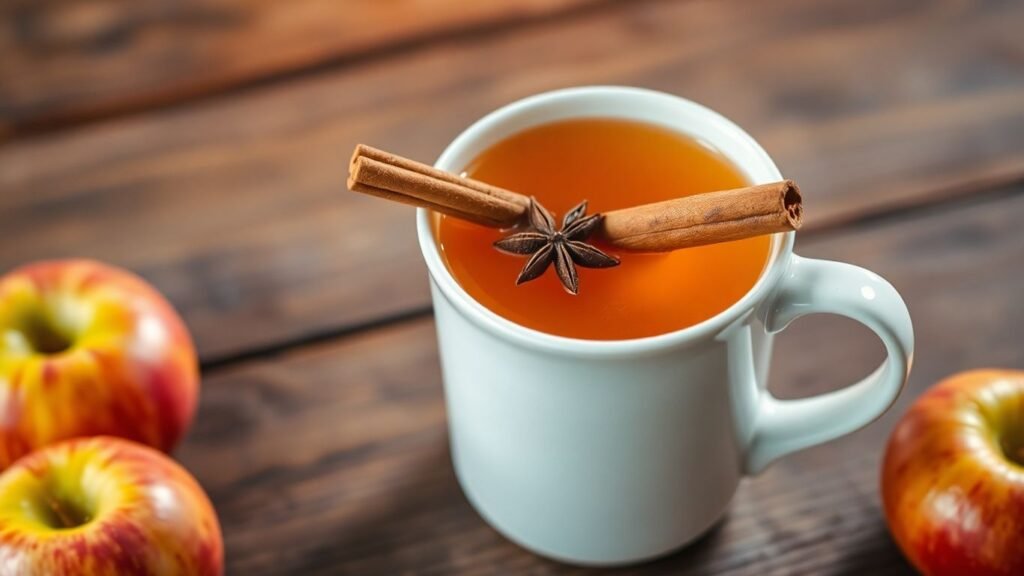Making hot spiced apple cider at home is a fantastic way to bring those cozy fall vibes into your kitchen. Forget the store-bought stuff that often lacks real spice and has too much sugar. This guide is all about creating a rich, flavorful apple cider that fills your home with an amazing aroma. We’ll cover everything from picking the right apples or juice to getting that perfect simmer and adding your personal touch. Get ready for a truly delicious and warming drink.
Key Takeaways
- Start with pure apple juice or whole apples for the best flavor base for your apple cider.
- Combine whole and ground spices like cinnamon, cloves, and allspice for a classic warm flavor.
- Simmering time is flexible; longer simmering generally results in a richer, more complex apple cider.
- Customize your apple cider by adjusting sweetness with maple syrup or sugar, and experimenting with different spice blends.
- Serve your finished apple cider warm with garnishes or chilled, and consider making spiced whipped cream for an extra treat.
Choosing Your Apple Base
Alright, let’s talk about the foundation of your amazing hot spiced apple cider: the apples themselves, or in some cases, the juice. This is where the real flavor starts, so picking the right stuff matters.
Understanding Apple Juice vs. Apple Cider
So, you might see
Essential Ingredients for Spiced Apple Cider

Alright, let’s talk about what goes into making that perfect mug of spiced apple cider. It’s not just about apples, though they are the star, of course. We’re building layers of flavor here, and the right ingredients make all the difference.
Aromatic Spices for Warmth
This is where the cozy really comes in. You want spices that give that classic fall feeling. Think cinnamon, cloves, star anise, and allspice. Using whole spices is generally better because they release their flavor more gradually and are easier to strain out later. Ground spices can work, but they can make your cider a bit cloudy and sometimes leave a gritty texture if not strained well.
- Cinnamon Sticks: The backbone of apple cider spice. Two or three sticks are usually plenty.
- Whole Cloves: These pack a punch, so a teaspoon is a good starting point.
- Star Anise: Adds a lovely licorice-like note and looks pretty too. One or two pods are enough.
- Allspice Berries: These taste like a mix of cinnamon, cloves, and nutmeg. A teaspoon of whole berries works well.
- Nutmeg: A whole nutmeg, grated fresh, is amazing, but a little ground nutmeg will do in a pinch.
Citrus Notes for Brightness
Don’t skip the citrus! A fresh orange, sliced or just the peel, adds a wonderful brightness that cuts through the sweetness and complements the spices. It really wakes up the flavor profile. Just be sure to trim away the white pith from the peel if you’re using that, as it can be a bit bitter.
Sweeteners to Enhance Flavor
While apples have their own natural sweetness, a little extra sweetener can really round things out. Maple syrup is a fantastic choice because it adds its own subtle, rich flavor that pairs beautifully with apples and spices. You can also use brown sugar or honey. The amount you use is totally up to your taste, so start with a little and add more if you think it needs it.
The goal is to balance the tartness of the apples, the warmth of the spices, and the overall sweetness. It’s a bit of an art, but tasting as you go is key.
Here’s a quick rundown of what you might need:
- 3 lbs apples, cored and chopped
- 1 large orange, sliced
- 2-3 cinnamon sticks
- 1 teaspoon whole cloves
- 1-2 star anise pods
- 1 teaspoon allspice berries
- 1/2 cup pure maple syrup (or to taste)
Mastering the Simmering Process

Alright, so you’ve got your apples or juice, and your spices are ready to go. Now comes the part where all those lovely flavors really start to meld together: the simmering. This is where the magic happens, transforming simple ingredients into that cozy, warm drink we all love.
Stovetop Simmering Techniques
When you’re simmering on the stovetop, the goal is a gentle, consistent heat. You want to bring your mixture to a low boil, then immediately reduce the heat so it’s just barely bubbling. Think of it as a lazy simmer, not a rolling boil. A heavy-bottomed pot is your best friend here, as it distributes heat more evenly and helps prevent scorching. Keep an eye on it, and give it a stir now and then. The longer it simmers, the more the flavors will deepen.
Instant Pot Apple Cider Magic
If you’re using an Instant Pot, you’ve got a couple of options. You can use the ‘Sauté’ function on low, just like you would on the stovetop, using the glass lid so you can see what’s happening. Alternatively, some people have success with the ‘Slow Cook’ setting, though it might take a bit longer to reach that perfect simmer. Remember, the sealed environment of the Instant Pot can concentrate flavors quickly, so adjust your simmering time accordingly.
Achieving the Perfect Simmer Time
So, how long should you let it simmer? It really depends on what you’re starting with and how intense you want the flavor. If you’re using just juice, 30 minutes to an hour is usually plenty to get the spices infused. If you’re simmering whole or chopped apples, you’ll want to go longer, maybe 1.5 to 2 hours, until the apples are really soft. This longer simmer time helps break down the apples and release more of their natural goodness into the cider.
Here’s a general guideline:
- Juice-based cider: 30 minutes to 1 hour
- Whole/Chopped Apple cider: 1.5 to 2 hours (or until apples are very tender)
Don’t be afraid to taste as you go! Your cider might need a little more time, or maybe it’s perfect. It’s all about finding that sweet spot for your taste buds.
Flavor Infusion and Customization
Once you have your base cider ready, the real fun begins: making it your own. This is where you can really play with the spices and sweetness to get that perfect taste.

Mashing Apples for Deeper Flavor
If you’re starting with whole apples, don’t just let them simmer away. After the initial cooking time, give them a good mash right in the pot. Use a sturdy spoon or even a potato masher. This breaks down the apple pieces, releasing more of their natural flavor and pectin into the liquid. It really makes a difference in the final depth of your cider. You’ll want to let it simmer for another hour or so after mashing to let those flavors really meld.
Adjusting Sweetness to Your Liking
Sweetness is super personal, right? What one person finds perfect, another might think is too much. Start with a base sweetener, like maple syrup or brown sugar, and add it gradually. Taste as you go. Remember, you can always add more, but you can’t take it out. If you find it’s not sweet enough, try a bit more maple syrup, honey, or even a touch of agave. For a less processed option, raw honey is a great choice.
Creative Spice Combinations
While the classic cinnamon, cloves, and allspice are fantastic, don’t be afraid to experiment. Think about adding a star anise for a licorice note, a few cardamom pods for a floral hint, or even a slice of fresh ginger for a bit of zing. Some people even like a tiny bit of black pepper for a subtle warmth. Just remember that some spices, like whole nutmeg, can sometimes leave an unexpected aftertaste for some people, so maybe try it in a smaller batch first.
Here’s a little chart to get your ideas flowing:
| Spice | Flavor Profile |
|---|---|
| Cinnamon | Warm, sweet, woody |
| Cloves | Pungent, sweet, warm |
| Allspice | Mix of cinnamon, clove, nutmeg |
| Star Anise | Sweet, licorice-like |
| Ginger (fresh) | Spicy, zesty, warming |
| Cardamom | Floral, citrusy, sweet |
Don’t be shy about trying new things. The beauty of homemade cider is its adaptability. What works for one person might inspire a whole new favorite combination for you. Keep notes on what you try so you can recreate your best batches.
Straining and Serving Your Apple Cider

Once all that simmering and mashing is done, you’re left with a pot full of deliciousness, but also a lot of apple bits and spices. Getting a clear, smooth cider is where straining comes in. It might seem like a small step, but it really makes a difference in the final texture.
Essential Straining Tools
To get the best results, you’ll want a couple of things on hand. A fine-mesh sieve is pretty much a must-have. It catches most of the smaller bits that a colander would let through. For an even clearer cider, you can line that sieve with cheesecloth. This is especially helpful if you used ground spices, which can leave a bit of sediment. Some people even use a nut milk bag, which works similarly to cheesecloth but is often a bit sturdier.
Here’s a quick rundown of what you might need:
- Fine-mesh sieve
- Cheesecloth or nut milk bag
- A large bowl or heat-proof pitcher to strain into
- A spoon or ladle for pressing the solids
Serving Hot or Cold
One of the best things about homemade apple cider is its versatility. You can serve it piping hot, straight from the pot, which is perfect for a chilly evening. Just ladle it into mugs. If you prefer it cold, let it cool down to room temperature, then pour it into a pitcher and pop it in the fridge. It keeps well for a few days. Cold cider is surprisingly refreshing on a warmer fall day.
Garnishes for Presentation
Presentation really does add to the experience, doesn’t it? Even simple garnishes can make your cider feel a bit more special. A classic choice is a cinnamon stick, which also adds a nice aroma. You could also float a thin slice of apple or orange on top. For a real treat, consider adding a dollop of spiced whipped cream – it’s like a dessert in a mug!
Don’t be afraid to get a little creative with your serving. Sometimes, just a little extra touch makes all the difference in how much people enjoy what you’ve made. It shows you put in that extra bit of care.
If you’re looking for a good starting point for making cider from scratch, this recipe for homemade apple cider is a great place to begin.
Elevating Your Apple Cider Experience

So, you’ve made a fantastic batch of hot spiced apple cider. That’s great! But why stop there? You can really make it special with a few simple touches. It’s all about those little extras that turn a good drink into a memorable one.
Crafting Spiced Whipped Cream
Forget the canned stuff. Making your own whipped cream is surprisingly easy and tastes so much better. You can even add a pinch of cinnamon, nutmeg, or a dash of apple pie spice to the cream before whipping for an extra flavor boost. It’s a simple way to add a creamy, spiced topping that really complements the cider.
Ingredients for Spiced Whipped Cream:
- 1 cup heavy whipping cream
- 2 tablespoons powdered sugar (or to taste)
- 1/2 teaspoon vanilla extract
- 1/4 teaspoon ground cinnamon (or a pinch of nutmeg)
Just whip the cream, sugar, vanilla, and spice together until soft peaks form. It’s a nice touch for guests, or just for yourself!
Creative Variations and Additions
Don’t be afraid to play around with your cider. Want a little zing? Add a knob of fresh ginger when you simmer. Prefer a different spice profile? Try adding a star anise or a few cardamom pods. You can even toss in a chai tea bag during the last 30 minutes of simmering for a chai-spiced cider.
Here are a few ideas to get you started:
- Citrus Twist: Add a few strips of orange or lemon peel (make sure to avoid the white pith, as it can be bitter) to the pot while simmering. This adds a lovely brightness.
- Ginger Kick: A few slices of fresh ginger can add a warm, spicy note that’s different from cinnamon and cloves.
- Maple Magic: Swap out some or all of the sweetener for maple syrup for a richer, deeper flavor.
- Boozy Boost: For an adult-only treat, a splash of bourbon, rum, or brandy stirred in just before serving is always a hit.
Pairing Cider with Fall Delights
Hot spiced apple cider is practically the official drink of autumn, and it pairs wonderfully with classic fall treats. Think about serving it alongside:
- Baked Goods: Apple pie, cinnamon donuts, or even simple sugar cookies are perfect companions.
- Savory Snacks: A sharp cheddar cheese or some spiced nuts can offer a nice contrast to the sweet cider.
- Hearty Meals: It’s a great drink to have with a bowl of chili or a hearty stew.
The aroma alone from a pot of simmering cider can make your whole house feel cozy. Adding a dollop of spiced whipped cream or a cinnamon stick garnish just makes it feel like a special occasion, even on a regular Tuesday.
Sip and Savor the Season
So there you have it – your very own homemade hot spiced apple cider. It’s really not that complicated, is it? You’ve gone from a simple bottle of juice to something truly special, filling your home with that amazing fall aroma. Whether you’re serving it at a get-together or just enjoying a quiet moment, this cider is sure to bring some warmth. Don’t be afraid to tweak the spices or sweetness next time; that’s part of the fun. Enjoy every cozy sip!
Frequently Asked Questions
What’s the difference between apple cider and apple juice?
Apple cider is like the unfiltered version of apple juice, made from crushed apples. It might be boiled before bottling and is often kept stable with pasteurization. While some store-bought ciders have spices, not all do. Apple juice, on the other hand, is filtered. Many brands use apple juice concentrate, which means water, sugar, and preservatives are often added back in. For the real deal, look for ‘cold-pressed’ or ‘100% apple juice’ on the label.
Does apple cider have alcohol in it?
Regular apple cider is a tasty, non-alcoholic drink made by simmering apples with spices like cinnamon and nutmeg. If it has alcohol, it’s called ‘hard’ apple cider, which is made by fermenting the apples. You’ll usually see the word ‘hard’ on the label if it contains alcohol, and it often has about as much alcohol as beer.
Do I have to add sugar to my apple cider?
Not necessarily! Apple cider made from pure apple juice or fresh apples is already a little sweet from the fruit’s natural sugars. But if you like things sweeter, you can easily dissolve a bit of honey or sugar into the cider at the end of cooking. Just a couple of tablespoons for a quart should do the trick!
What kind of apples are best for making cider?
You can use pretty much any apples you like! A mix of tart apples, like Granny Smith, and sweet apples, such as Gala or Golden Delicious, often gives the best flavor. But feel free to experiment with your favorite varieties.
Can I use ground spices instead of whole spices?
Yes, you absolutely can! Ground spices work just fine. The main difference is that whole spices are easier to remove when you strain the cider. If you use ground spices, just give your cider a good shake or stir before serving to make sure all the flavors are mixed in.
How long should I simmer the apple cider?
For a good flavor, you’ll want to simmer the cider for at least 2 to 3 hours. Some recipes suggest mashing the apples halfway through and simmering for another hour to get even more flavor out. The longer it simmers, the richer and deeper the taste will become, and your house will smell amazing!


